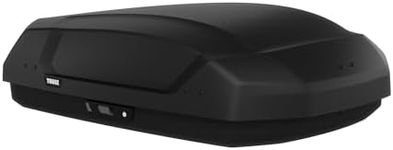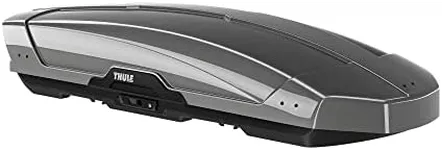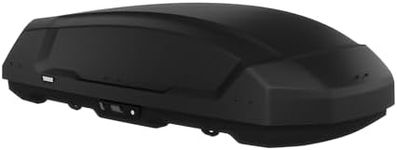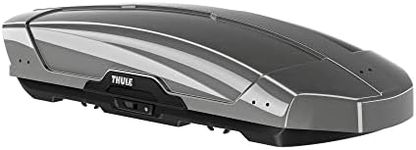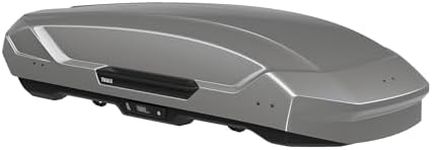Buying Guide for the Best Roof Boxes
Choosing the right roof box can greatly enhance your travel experience by providing additional storage space for your vehicle. It's important to consider the size, shape, and features of the roof box to ensure it meets your needs and fits your vehicle properly. Think about what you plan to store in the roof box, how often you'll use it, and the type of trips you'll be taking. This will help you determine the best roof box for your lifestyle.CapacityCapacity refers to the amount of storage space available inside the roof box, usually measured in liters. This is important because it determines how much you can store in the box. Roof boxes come in various sizes, typically ranging from around 300 to 600 liters. If you plan to carry a lot of gear, such as camping equipment or luggage for a family trip, you might need a larger capacity. For occasional use or smaller loads, a smaller capacity might suffice. Consider the size of your vehicle and the type of items you need to store when choosing the capacity.
DimensionsThe dimensions of a roof box include its length, width, and height. These are crucial because they affect how the box fits on your vehicle and what you can store inside. Longer boxes are great for items like skis or snowboards, while wider boxes can accommodate bulkier items. Make sure the dimensions of the roof box are compatible with your vehicle's roof and that it doesn't obstruct your view or interfere with opening the trunk. Consider the types of items you plan to carry and ensure the dimensions will accommodate them.
Weight LimitThe weight limit of a roof box indicates the maximum weight it can safely carry. This is important for safety and to avoid damaging your vehicle's roof. Roof boxes typically have weight limits ranging from 50 to 75 kg. It's crucial to not exceed this limit, as it can affect your vehicle's handling and fuel efficiency. Consider the weight of the items you plan to carry and ensure they fall within the roof box's weight limit. Also, check your vehicle's roof load capacity to ensure it can support the combined weight of the roof box and its contents.
MaterialRoof boxes are made from various materials, with the most common being ABS plastic and fiberglass. The material affects the durability, weight, and weather resistance of the roof box. ABS plastic is lightweight, durable, and resistant to UV rays, making it a popular choice. Fiberglass is also durable and can be more aerodynamic, but it tends to be heavier. Consider the climate and conditions you'll be using the roof box in, as well as how often you'll be using it, to determine which material is best for you.
AerodynamicsAerodynamics refers to how well the roof box cuts through the air while driving. This is important because it affects fuel efficiency and noise levels. Roof boxes with a more aerodynamic design, often with a sleek, tapered shape, can reduce wind resistance and improve fuel economy. If you plan to use the roof box frequently or for long trips, choosing a more aerodynamic model can save you money on fuel and provide a quieter ride. Consider your typical driving conditions and how important fuel efficiency is to you when evaluating aerodynamics.
Mounting SystemThe mounting system is how the roof box attaches to your vehicle's roof rack. This is important for ease of installation and security. Some roof boxes have quick-mount systems that make installation fast and easy, while others may require more time and tools. Ensure the mounting system is compatible with your vehicle's roof rack and that it provides a secure fit. If you plan to frequently remove and reinstall the roof box, a quick-mount system might be more convenient. Consider how often you'll be installing the roof box and your comfort level with installation when choosing a mounting system.
Security FeaturesSecurity features in a roof box include locks and latches that keep your belongings safe. This is important to prevent theft and ensure the box stays closed while driving. Most roof boxes come with a central locking system that secures the box at multiple points. Some may also have additional features like keyless entry or tamper-proof locks. Consider the value of the items you'll be storing and the level of security you need. If you plan to leave the roof box unattended in public areas, investing in a model with robust security features is advisable.


